This week at an online open house, SDOT released the results of a survey the department conducted last year around the concept of creating a path for people walking and rolling along the Outer Loop along Green Lake Park’s western edge. Adjacent to Aurora Ave, no sidewalk currently exists, just a dirt path that frequently turns to mud. The idea of repurposing the curbside lane of Aurora, which is actually a continuation of a bus lane on a stretch of road that buses don’t currently use, as a space for people to walk and bike has been kicking around SDOT since mid-2020, according to records Seattle Bike Blog obtained last year. After hearing from over 5,000 people, a huge response for a survey like this, 40% of people said they supported the idea of converting the lane of Aurora compared to 29% of people who said they opposed it.
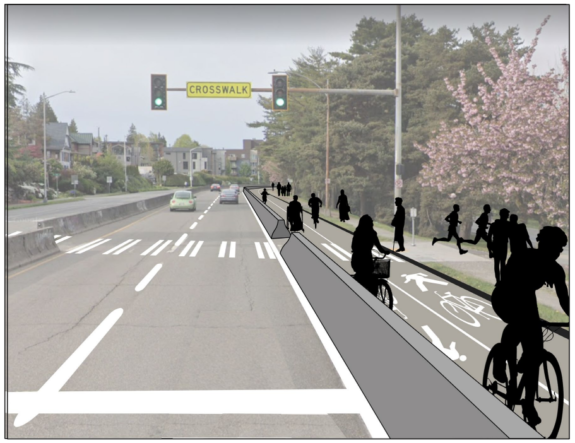
SDOT also announced that they’ve selected an alternative to the final connection between this new Aurora path and the existing protected bike lane at the north end of the lake, via West Green Lake Drive N. The final design will be a two-way protected biking and walking lane along the lake side, with the rest of the street shifting to a new one-way traffic pattern in the southbound direction in order to retain parking along the street for residents. SDOT says they discarded making the street northbound due to concern about additional traffic diversion for drivers trying to head southbound. This option actually narrowly lost to the option that included parking removal, 42% to 47% but was the one selected by the city.
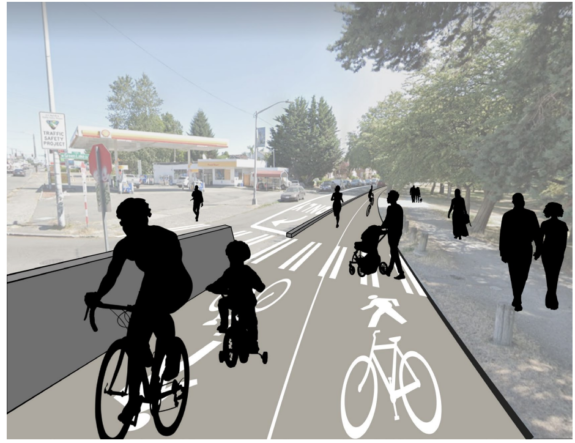
And finally, the department announced that the project, which didn’t previously have construction funding identified, is now fully funded via the city’s Vision Zero program. Most of the $1 million cost is anticipated to come from purchasing concrete barriers for the segment along Aurora, but SDOT says they are looking at how to repurpose existing barriers from elsewhere to keep costs down. The Vision Zero program is expected to see a higher amount of revenue in the next few years thanks to an increase in the city’s commercial parking tax set to take effect this year. Previously Vision Zero funding has been used to create separated space for people to bike on 12th Ave S in Little Saigon and on NE 65th Street.
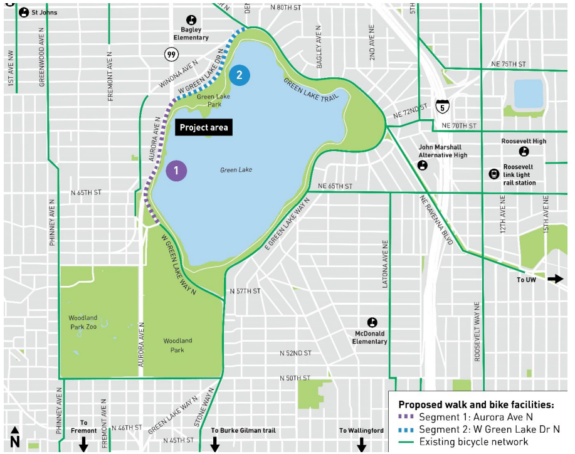
The survey, like nearly all surveys on transportation projects, wasn’t exactly representative of Seattle as a whole: only 22% of respondents said they are renters (renters are a majority of Seattle residents) and 80% of respondents said they are white. Green Lake Park receives some of the highest usage in the entire Seattle Parks system and how to use the street space immediately adjacent to it is a citywide concern, although attention to impacts to nearby residents should certainly be paid.
During the open house, SDOT shared early renderings of how the facility will work at the transition points between the different segments, including the infamous slip lane from Aurora onto West Green Lake Dr N, where drivers will no longer be allowed to exit because of the conversion to one-way traffic.
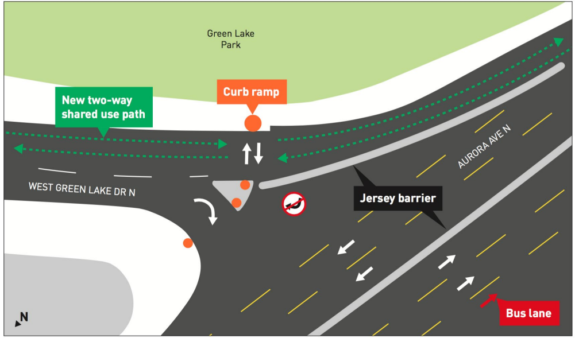
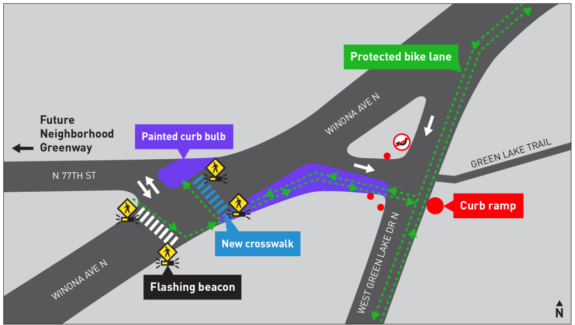
During the meeting, SDOT staff outlined a “worst-case scenario” of traffic impacts from the conversion of West Green Lake Dr N to one way operation: an additional 500 vehicles using Winona Ave N instead and an average delay per vehicle of 18 seconds for drivers turning off Aurora. In return, the city will be creating a pathway for people biking around the entirety of Green Lake Park. Currently Seattle Parks is prohibiting people on bikes from using the inner loop trail, with a permanent restriction on the table as that department assesses the competing uses for that trail.
Creating joint walking and biking space isn’t a widespread habit of the department, but in this case allowing people who walk or roll to use the bike space is probably the only way the city was going to be able to cheaply create an ADA-compliant pathway around the west edge of Green Lake Park. Because SDOT is treating the new facility as a multi-use trail, they will not be installing traffic signals for bike traffic at the signalized crosswalks across Aurora as they might with a protected bike lane project.
SDOT is currently aiming for a construction date of “Summer-Fall” 2022 for all of these improvements, making it one of the fastest rollouts of quick build protected biking and walking infrastructure in recent memory. Across town, the department has still not even announced a planned route for a safe biking corridor in north Beacon Hill after spending all of 2021 doing outreach around the different options. This disparity can’t be ignored when looking at the Green Lake Outer Loop project and the vast differences in the ability of different areas of the city to be able to move projects like this forward.
You can read more about the Green Lake Outer Loop at the project website.








Comments
8 responses to “SDOT solidifies proposal for fully funded Green Lake Outer Loop project”
I am for the outer loop. But Parks should not use the outer loop as an excuse to ban wheeled traffic on the inner loop. Faster cyclists and other fast wheeled users / joggers will take the outer loop, but those with kids, disabilities, or simply bird-watching can operate safely on the inner loop, using their discretion to choose a time that is less crowded.
I agree. Toddlers riding bikes with training wheels at 5 mph, while their parents walk or jog alongside belong on the inner loop, not the outer loop. And, rules should not get in the way of that.
Of course, fast cyclists should use the outer loop.
Completely agree with comment above – The inner loop should be open to kiddos on bikes as it maintains the faintly friendly environment. No bikers riding at an accelerated pace should be allowed. It’s ridiculous.
Bet hey – another family friendly project would be to remove the insane amount of vagrants and homeless drug users in Woodland Park…Rather then build more and more and more bike lanes…
The inner loop is effectively a walking path as it is used now. While you can ride on it, there is so much foot traffic you have to go jogging slow. If they do ban or discourage wheeled traffic on the inner loop, I kind of doubt they will be chasing after kids and people in wheelchairs to write them tickets.
I was glad to see they picked the one way option for the West Green Lake Dr. N. in Phase 2. Commuters who short cut the Winona intersection treat it like a freeway on ramp. One of my perverse pleasures if I’m driving is following the city speed limits.
If you go at the right time of day / day of week, no issue with crowds. I am fine with discouraging (the crowds already do that), but banning and relying on prosecutorial discretion turns into BS like mandating bicycle helmets.
Ryan wrote: “The idea of repurposing the curbside lane of Aurora, which is actually a continuation of a bus lane on a stretch of road that buses don’t currently use…”. This is false. The northbound outside lane was never a bus lane. The Aurora consolidation was in February 1999; Route 358 replaced routes 6, 359, and 360; Route 358 served Linden Avenue North in both directions. When the E Line replaced Route 358, in February 2014, it served Linden Avenue North northbound. It still does. In 2014, SDOT may have applied some paint incorrectly.
Eighteen whole seconds of delay for cars! Outrageous. Kill the entire project!
Seriously, pretty amazing you can get this much benefit for so little impact.
Remind me why we let cars drive everywhere?
Thanks so much, love to see your reporting here Ryan! Thorough and detailed as always.